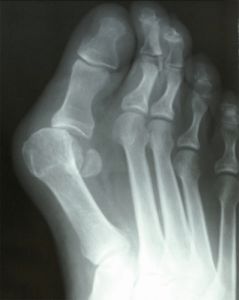
Here at the Washington Bunion Center, Dr. Brandon Nelson and Dr. Timothy Young, one of our biggest goals during the postoperative healing phase is to do everything possible to speed-up the healing process, and especially the bone healing process. This starts out by effective protection for the foot and ankle and leg during this timeframe. Initially the patient is in a splint. Then we placed the patient in the special fiberglass cast. The fiberglass cast typically will have a walking heel as far back as possible. This allows for full weightbearing on the heel without any pressure in the forefoot. To make this more comfortable for the patient we will split the fiberglass cast (bivalve) and tape the seems. This allows for better access for physical therapy and for bathing. This special fiberglass cast has been fine-tuned in our clinic to make our patient’s as comfortable as possible and to help maximize healing. Another component for healing is the bone healing itself. It is critical to take supplements to help maximize bone healing. This includes calcium and vitamin D magnesium and vitamin K 2. We recommend Orthotic Pro Bono supplement and it is available at our clinic for our patients. In addition to the supplements, there is some studies the taking arginine supplements can be beneficial. Some of our patient’s may require a bone stimulation unit also. There are several different technologies available. One utilizes a pulsed ultrasound unit (Exogen), and the other major technology utilizes a pulsed electronegative magnetic field (PEMF). To summarize, proper bone healing during the postoperative phase of bunion surgery includes proper immobilization, nutrition, and even physiology such as bone stimulation units. Here at the Washington Bunion Center, for both Dr. Brandon Nelson and Dr. Timothy Young, our goal is to speed up the postoperative bone healing so that our patients can fully and quickly recover from bunion surgery.





 Many people tend to postpone addressing painful conditions with their feet or ankles. Often, people believe that pain in their feet is just something they have to live with. Perhaps the most common complaint of our patients with persistent pain is bunions.
Many people tend to postpone addressing painful conditions with their feet or ankles. Often, people believe that pain in their feet is just something they have to live with. Perhaps the most common complaint of our patients with persistent pain is bunions. surgery is typically performed with a local anesthesia and either Arthroplasty or Osteotomy is performed. These procedures will reshape or cut the protrusion and typically titanium screws are inserted. The surgical screws will hold the bones in the new corrected position and provide long term stability to the area.
surgery is typically performed with a local anesthesia and either Arthroplasty or Osteotomy is performed. These procedures will reshape or cut the protrusion and typically titanium screws are inserted. The surgical screws will hold the bones in the new corrected position and provide long term stability to the area.
 Fungal toenails, ugly toenails or nails that are thick and crumbly can be disturbing. We see a lot of patients that come in concerned over the appearance of her nails. The most common cause of ugly toes is a fungus. However, this also can be posttraumatic patients who have stubbed their toe and had some sort of injury like running or shoes that were too small. We have taken years developed a protocol to treat these fungally infected toenails. Our current protocol has a success rate approaching 90%. We have developed away to treat these stub her nails. If you have tried multiple other treatment modalities or you have nails that are fungal call us to make an appointment. We see patient’s from Seattle with fungal nails, Bellevue with fungal nails, Issaquah with fungal nails and all over the Eastside. Please call 425-391-8666.
Fungal toenails, ugly toenails or nails that are thick and crumbly can be disturbing. We see a lot of patients that come in concerned over the appearance of her nails. The most common cause of ugly toes is a fungus. However, this also can be posttraumatic patients who have stubbed their toe and had some sort of injury like running or shoes that were too small. We have taken years developed a protocol to treat these fungally infected toenails. Our current protocol has a success rate approaching 90%. We have developed away to treat these stub her nails. If you have tried multiple other treatment modalities or you have nails that are fungal call us to make an appointment. We see patient’s from Seattle with fungal nails, Bellevue with fungal nails, Issaquah with fungal nails and all over the Eastside. Please call 425-391-8666.
